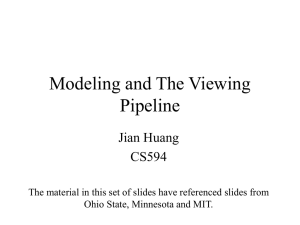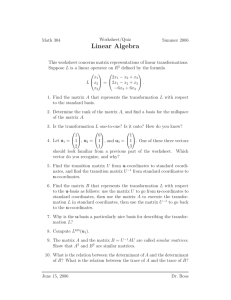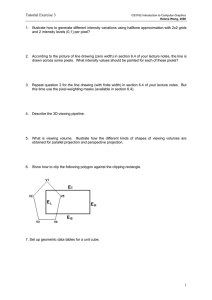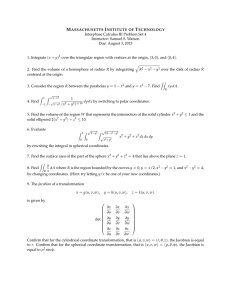Models and The Viewing Pipeline Jian Huang CS456
advertisement
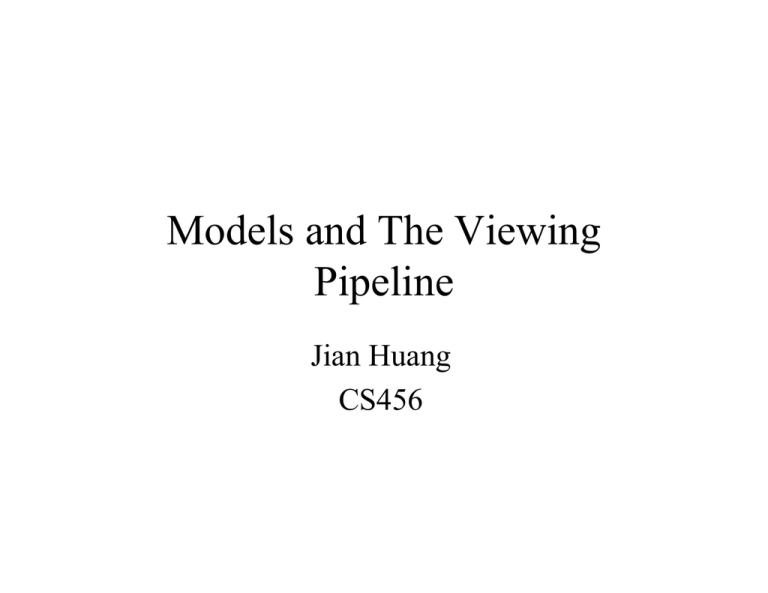
Models and The Viewing Pipeline Jian Huang CS456 Polygon Mesh • Vertex coordinates list, polygon table and (maybe) edge table • Auxiliary: – Per vertex normal – Neighborhood information, arranged with regard to vertices and edges Transformations – Need ? • Modeling transformations • build complex models by positioning simple components • Viewing transformations • placing virtual camera in the world • transformation from world coordinates to eye coordinates • Animation: vary transformations over time to create motion EYE OBJECT WORLD Viewing Pipeline Object Space World Space Eye Space Clipping Space Canonical view volume Screen Space • Object space: coordinate space where each component is defined • World space: all components put together into the same 3D scene via affine transformation. (camera, lighting defined in this space) • Eye space: camera at the origin, view direction coincides with the z axis. Hither and Yon planes perpendicular to the z axis • Clipping space: do clipping here. All point is in homogeneous coordinate, i.e., each point is represented by (x,y,z,w) • 3D image space (Canonical view volume): a parallelpipied shape defined by (-1:1,-1:1,0,1). Objects in this space is distorted • Screen space: x and y coordinates are screen pixel coordinates Spaces Object Space and World Space: eye Eye-Space: 3. Spaces Clip Space: Image Space: 1. 2. 3. 4. 5. 6. 2D Transformation • Translation • Rotation Homogeneous Coordinates • Matrix/Vector format for translation: Translation in Homogenous Coordinates • There exists an inverse mapping for each function • There exists an identity mapping Why these properties are important • when these conditions are shown for any class of functions it can be proven that such a class is closed under composition • i. e. any series of translations can be composed to a single translation. Rotation in Homogeneous Space The two properties still apply. Putting Translation and Rotation Together • Order matters !! Affine Transformation • Property: preserving parallel lines • The coordinates of three corresponding points uniquely determine any Affine Transform!! Affine Transformations • • • • Translation Rotation Scaling Shearing T How to determine an Affine 2D Transformation? • We set up 6 linear equations in terms of our 6 unknowns. In this case, we know the 2D coordinates before and after the mapping, and we wish to solve for the 6 entries in the affine transform matrix Affine Transformation in 3D • Translation • Rotate • Scale • Shear More Rotation • Which axis of rotation is this? Viewing • Object space to World space: affine transformation • World space to Eye space: how? • Eye space to Clipping space involves projection and viewing frustum Perspective Projection Image W F I World • Projection point sees anything on ray through pinhole F • Point W projects along the ray through F to appear at I (intersection of WF with image plane) Image Formation Image F World Projecting shapes • project points onto image plane • lines are projected by projecting its end points only Orthographic Projection • focal point at infinity • rays are parallel and orthogonal to the image plane Image F W I World World Image F Comparison Simple Perspective Camera • camera looks along z-axis • focal point is the origin • image plane is parallel to xy-plane at distance d • d is call focal length for historical reason Similar Triangles Y [Y, Z] [(d/Z)Y, d] Z [0, 0] [0, d] • Similar situation with x-coordinate • Similar Triangles: point [x,y,z] projects to [(d/z)x, (d/z)y, d] Projection Matrix Projection using homogeneous coordinates: – transform [x, y, z] to [(d/z)x, (d/z)y, d] d 0 0 0 0 d 0 0 0 0 x d 0 0 y d = [dx dy dz z ] x y d z z d 0 z Divide by 4th coordinate 1 01 (the “w” coordinate) • 2-D image point: • discard third coordinate • apply viewport transformation to obtain physical pixel coordinates View Volume • Defines visible region of space, pyramid edges are clipping planes • Frustum :truncated pyramid with near and far clipping planes – Near (Hither) plane ? Don’t care about behind the camera – Far (Yon) plane, define field of interest, allows z to be scaled to a limited fixed-point value for z-buffering. Difficulty • It is difficult to do clipping directly in the viewing frustum Canonical View Volume • Normalize the viewing frustum to a cube, canonical view volume • Converts perspective frustum to orthographic frustum – perspective transformation Perspective Transform • The equations alpha = yon/(yon-hither) beta = yon*hither/(hither - yon) s: size of window on the image plane z’ alpha 1 yon hither z About Perspective Transform • Some properties About Perspective Transform • Clipping can be performed against the rectilinear box • Planarity and linearity are preserved • Angles and distances are not preserved • Side effects: objects behind the observer are mapped to the front. Do we care? Perspective + Projection Matrix • AR: aspect ratio correction, ResX/ResY • s= ResX, • Theta: half view angle, tan(theta) = s/d Camera Control and Viewing Focal length (d), image size/shape and clipping planes included in perspective transformation Angle or Field of view (FOV) AR Aspect Ratio of view-port Hither, Yon Nearest and farthest vision limits (WS). eye Lookat - coi Lookfrom - eye coi hither yon View angle - FOV Complete Perspective • Specify near and far clipping planes transform z between znear and zfar on to a fixed range • Specify field-of-view (fov) angle • OpenGL’s glFrustum and gluPerspective do these More Viewing Parameters Camera, Eye or Observer: lookfrom:location of focal point or camera lookat: point to be centered in image Camera orientation about the lookat-lookfrom axis vup: a vector that is pointing straight up in the image. This is like an orientation. Implementation … Full Blown • Translate by -lookfrom, bring focal point to origin • Rotate lookat-lookfrom to the z-axis with matrix R: • v = (lookat-lookfrom) (normalized) and z = [0,0,1] • rotation axis: a = (vxz)/|vxz| • rotation angle: cos = a•z and sin = |rxz| • OpenGL: glRotate(, ax, ay, az) • Rotate about z-axis to get vup parallel to the y-axis Viewport mapping • Change from the image coordinate system (x,y,z) to the screen coordinate system (X,Y). • Screen coordinates are always non-negative integers. • Let (vr,vt) be the upper-right corner and (vl,vb) be the lower-left corner. • X = x * (vr-vl)/2 + (vr+vl)/2 • Y = y * (vt-vb)/2 + (vt+vb)/2 True Or False • In perspective transformation parallelism is not preserved. – Parallel lines converge – Object size is reduced by increasing distance from center of projection – Non-uniform foreshortening of lines in the object as a function of orientation and distance from center of projection – Aid the depth perception of human vision, but shape is not preserved True Or False • Affine transformation is a combination of linear transformations • The last column/row in the general 4x4 affine transformation matrix is [0 0 0 1]T. • After affine transform, the homogeneous coordinate w maintains unity.
